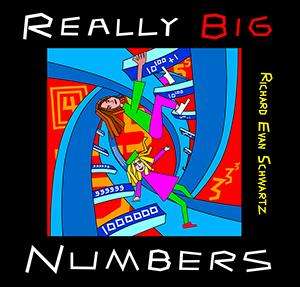Children's book explores Really Big Numbers

A new children's book written and illustrated by a Brown mathematics professor Richard Schwartz takes readers on a visual journal through the infinite number system. Schwartz hopes Really Big Numbers will help inspire a love of math in young readers.
Really Big Numbers is the second children's book written by Richard Schwartz, Chancellor's Professor of Mathematics at Brown. The book, which Schwartz illustrated himself, takes readers on a visual tour of the number system—starting with small, relatable numbers and building to giant, unimaginable ones. Schwartz hopes the book might help young readers develop their number sense, while discovering the awe and wonder of math. He spoke with Kevin Stacey about the project.
What was your inspiration for this book?
The original inspiration, way back in my subconscious, was from when I was in an 11th grade chemistry class. The teacher gave an account of Avogadro's number (the number of atoms in one mole of a given substance). He talked about how far you could stack cars out to space, or something like that. I remember that really captured my imagination, and the idea just always simmered in the back of my mind. I thought it would be great to have some visual description of Avogadro's number and other really big numbers. I like to write comic books and draw, so I started to just think of numbers and then draw a picture. The book grew from there. It was one of those half-baked ideas that finally got baked.
Could you describe the kinds of visualizations you included?
I tried to use everyday things—the number of hairs on a human head, or the number of grains of sand would it take to bury a person. I also have things like the number of basketballs would it take to fill up Manhattan to the level of six feet, and the number of trampolines it would take to cover the earth. I also tried to put in some combinatorial things that are surprisingly large. I think the most striking one is the number of different ways to visit all the contiguous 48 states. There turns out to be more ways to do that than there are atoms in the Earth.
Why do you think it's helpful to have some visual reference for big numbers?
I think this is really important for getting a sense of mathematical intuition. It's the same way it's nice to know what triangles and squares and basic shapes are like. Numbers are a fundamental part of the landscape and having a good feel for them is important. I also think it's important for society that adults to have a sense of numbers. We often hear things like there's this much national debt or this much of an increase in unemployment. People make decisions and vote based on these numbers. If people have a good number sense they can sort through all this information and have an idea of what's significant. A good number sense helps us view the world accurately. But one point from the book is that it eventually becomes impossible to visualize these things. You can start naming these really big numbers—say a googolplex—but in some sense there's really nothing there but the word. So the end of the book is about how you can still use language to describe numbers even when there is no picture to go along with the words. There are just some places, like way out on the number line, where human intuition will not go, but it is still possible to talk about those places.
What do you hope readers will take away from the book?
This is really about a sense of wonder. I think about when I was young—it happened a lot in college—when you're sitting around over pizza and talking about all these mind-blowing things. There was a good feeling that came from that, this feeling of awe. I wanted to put that in a book. If kids get a sense of the beauty or awesomeness of mathematics—instead of just having dry formulas or things they have to memorize—it might help them to study it or be interested in it later.
Provided by Brown University



















